IKEA Employee Relations: Conflict, Negotiation, and HRM Report
VerifiedAdded on 2020/01/28
|18
|6680
|1234
Report
AI Summary
This report examines employee relations within IKEA, a multinational company. It begins by defining employee relations and its importance in achieving organizational objectives, particularly in conflict resolution. The report explores the unitary and pluralistic frames of reference, highlighting IKEA's adoption of a unitarist perspective. It then provides a brief historical overview of trade unions, their evolution, and their role in supporting employees. The report analyzes the roles of key players in employee relations, including trade unions, ACAS, and government. It further details procedures organizations should follow when dealing with different conflict situations, including formal and informal conflicts, and the skills needed for effective resolution. The report also delves into negotiation in collective bargaining, the impact of negotiation strategies, and the influence of the EU on industrial democracy. Finally, it discusses methods for employee participation and the impact of human resource management on employee relations, concluding with the importance of employee involvement.
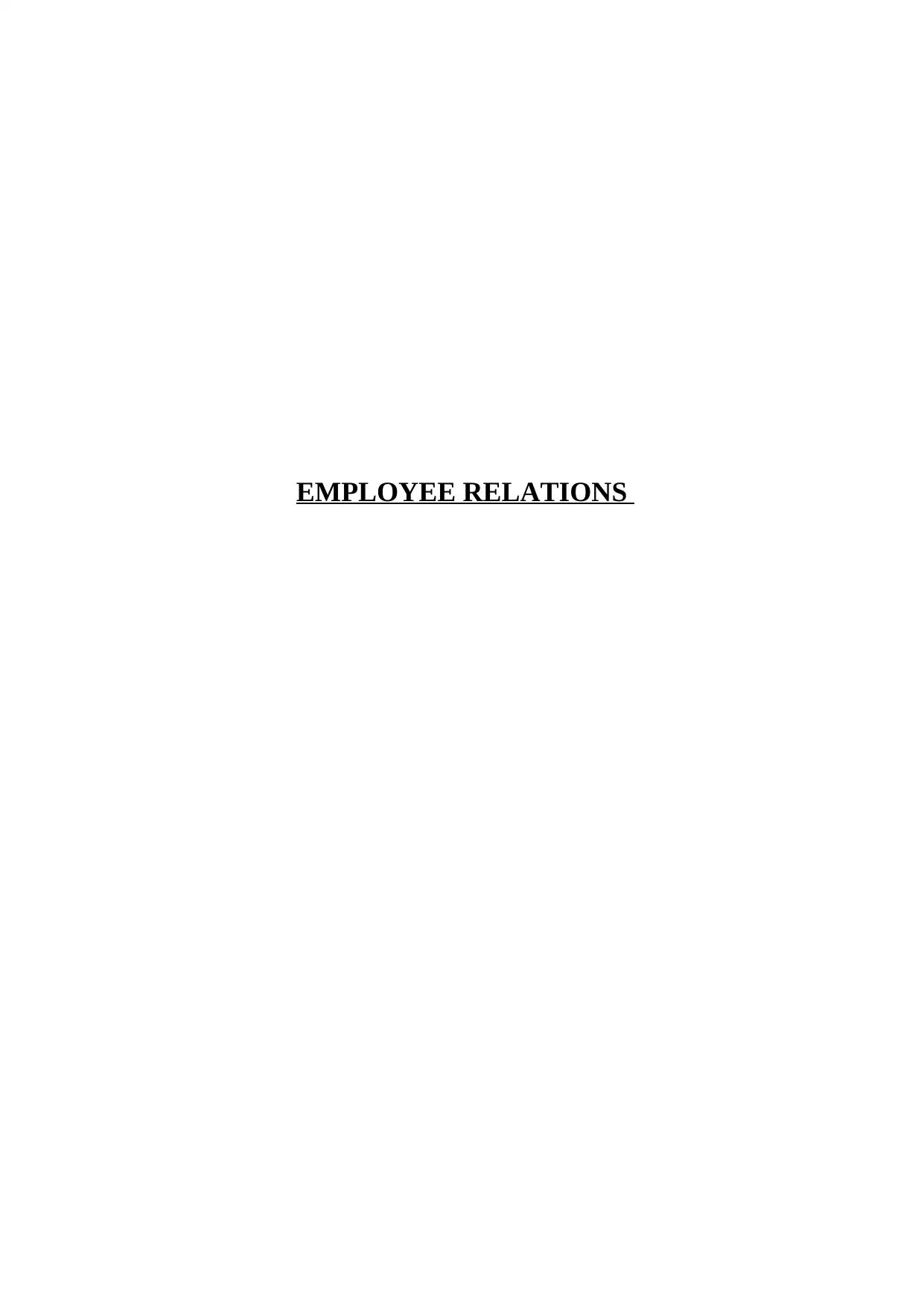
EMPLOYEE RELATIONS
Paraphrase This Document
Need a fresh take? Get an instant paraphrase of this document with our AI Paraphraser
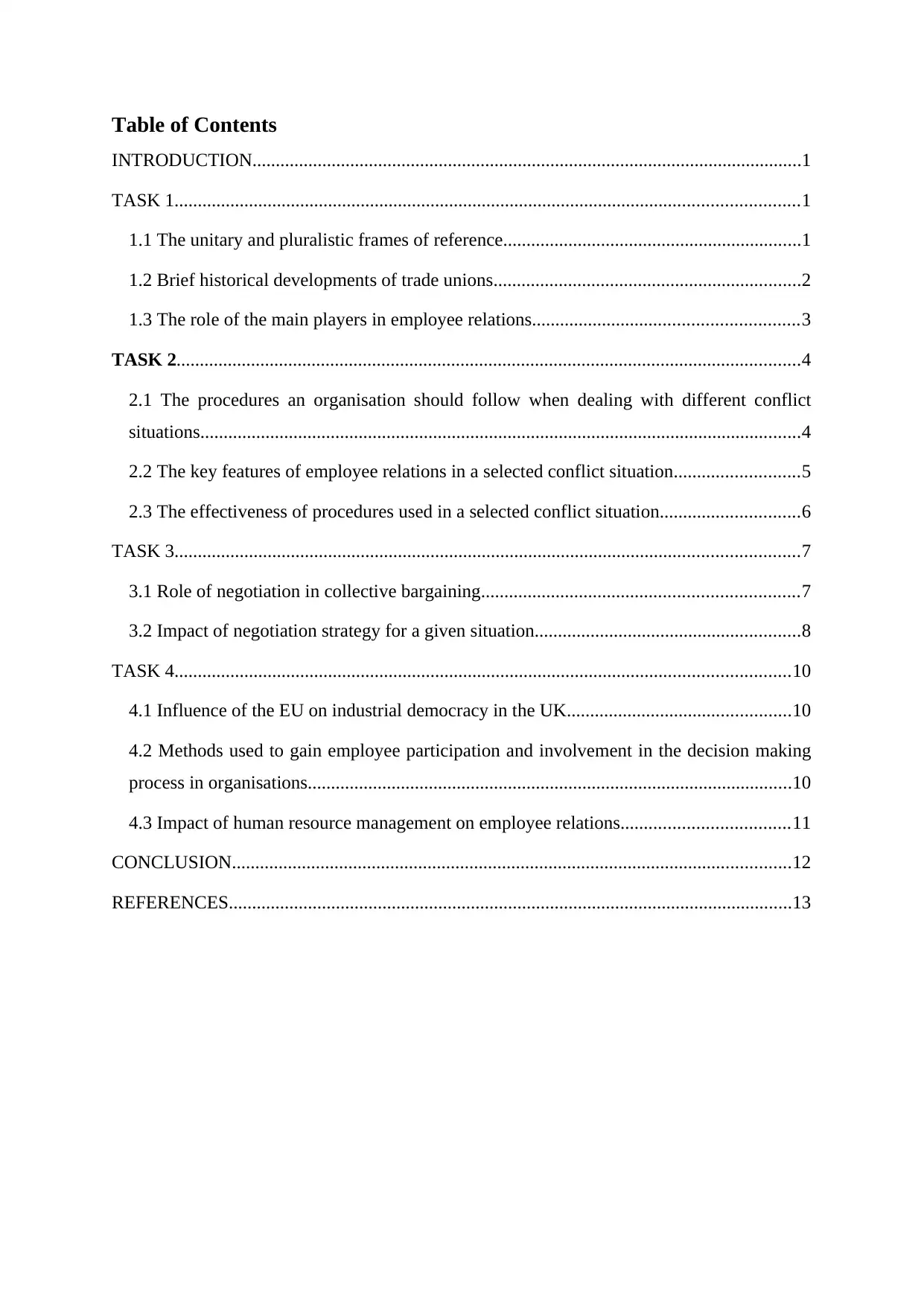
Table of Contents
INTRODUCTION......................................................................................................................1
TASK 1......................................................................................................................................1
1.1 The unitary and pluralistic frames of reference................................................................1
1.2 Brief historical developments of trade unions..................................................................2
1.3 The role of the main players in employee relations.........................................................3
TASK 2......................................................................................................................................4
2.1 The procedures an organisation should follow when dealing with different conflict
situations.................................................................................................................................4
2.2 The key features of employee relations in a selected conflict situation...........................5
2.3 The effectiveness of procedures used in a selected conflict situation..............................6
TASK 3......................................................................................................................................7
3.1 Role of negotiation in collective bargaining....................................................................7
3.2 Impact of negotiation strategy for a given situation.........................................................8
TASK 4....................................................................................................................................10
4.1 Influence of the EU on industrial democracy in the UK................................................10
4.2 Methods used to gain employee participation and involvement in the decision making
process in organisations........................................................................................................10
4.3 Impact of human resource management on employee relations....................................11
CONCLUSION........................................................................................................................12
REFERENCES.........................................................................................................................13
INTRODUCTION......................................................................................................................1
TASK 1......................................................................................................................................1
1.1 The unitary and pluralistic frames of reference................................................................1
1.2 Brief historical developments of trade unions..................................................................2
1.3 The role of the main players in employee relations.........................................................3
TASK 2......................................................................................................................................4
2.1 The procedures an organisation should follow when dealing with different conflict
situations.................................................................................................................................4
2.2 The key features of employee relations in a selected conflict situation...........................5
2.3 The effectiveness of procedures used in a selected conflict situation..............................6
TASK 3......................................................................................................................................7
3.1 Role of negotiation in collective bargaining....................................................................7
3.2 Impact of negotiation strategy for a given situation.........................................................8
TASK 4....................................................................................................................................10
4.1 Influence of the EU on industrial democracy in the UK................................................10
4.2 Methods used to gain employee participation and involvement in the decision making
process in organisations........................................................................................................10
4.3 Impact of human resource management on employee relations....................................11
CONCLUSION........................................................................................................................12
REFERENCES.........................................................................................................................13
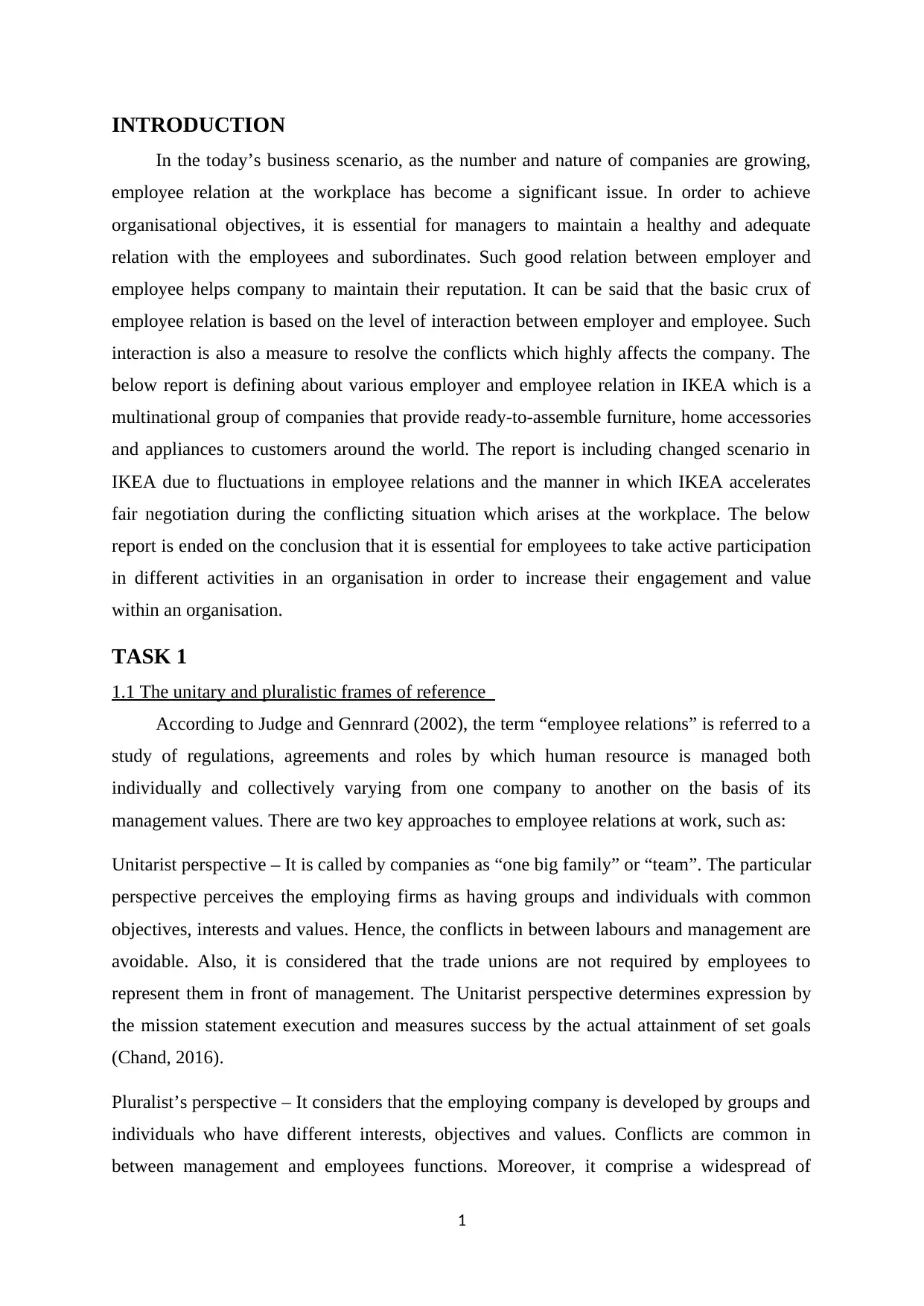
INTRODUCTION
In the today’s business scenario, as the number and nature of companies are growing,
employee relation at the workplace has become a significant issue. In order to achieve
organisational objectives, it is essential for managers to maintain a healthy and adequate
relation with the employees and subordinates. Such good relation between employer and
employee helps company to maintain their reputation. It can be said that the basic crux of
employee relation is based on the level of interaction between employer and employee. Such
interaction is also a measure to resolve the conflicts which highly affects the company. The
below report is defining about various employer and employee relation in IKEA which is a
multinational group of companies that provide ready-to-assemble furniture, home accessories
and appliances to customers around the world. The report is including changed scenario in
IKEA due to fluctuations in employee relations and the manner in which IKEA accelerates
fair negotiation during the conflicting situation which arises at the workplace. The below
report is ended on the conclusion that it is essential for employees to take active participation
in different activities in an organisation in order to increase their engagement and value
within an organisation.
TASK 1
1.1 The unitary and pluralistic frames of reference
According to Judge and Gennrard (2002), the term “employee relations” is referred to a
study of regulations, agreements and roles by which human resource is managed both
individually and collectively varying from one company to another on the basis of its
management values. There are two key approaches to employee relations at work, such as:
Unitarist perspective – It is called by companies as “one big family” or “team”. The particular
perspective perceives the employing firms as having groups and individuals with common
objectives, interests and values. Hence, the conflicts in between labours and management are
avoidable. Also, it is considered that the trade unions are not required by employees to
represent them in front of management. The Unitarist perspective determines expression by
the mission statement execution and measures success by the actual attainment of set goals
(Chand, 2016).
Pluralist’s perspective – It considers that the employing company is developed by groups and
individuals who have different interests, objectives and values. Conflicts are common in
between management and employees functions. Moreover, it comprise a widespread of
1
In the today’s business scenario, as the number and nature of companies are growing,
employee relation at the workplace has become a significant issue. In order to achieve
organisational objectives, it is essential for managers to maintain a healthy and adequate
relation with the employees and subordinates. Such good relation between employer and
employee helps company to maintain their reputation. It can be said that the basic crux of
employee relation is based on the level of interaction between employer and employee. Such
interaction is also a measure to resolve the conflicts which highly affects the company. The
below report is defining about various employer and employee relation in IKEA which is a
multinational group of companies that provide ready-to-assemble furniture, home accessories
and appliances to customers around the world. The report is including changed scenario in
IKEA due to fluctuations in employee relations and the manner in which IKEA accelerates
fair negotiation during the conflicting situation which arises at the workplace. The below
report is ended on the conclusion that it is essential for employees to take active participation
in different activities in an organisation in order to increase their engagement and value
within an organisation.
TASK 1
1.1 The unitary and pluralistic frames of reference
According to Judge and Gennrard (2002), the term “employee relations” is referred to a
study of regulations, agreements and roles by which human resource is managed both
individually and collectively varying from one company to another on the basis of its
management values. There are two key approaches to employee relations at work, such as:
Unitarist perspective – It is called by companies as “one big family” or “team”. The particular
perspective perceives the employing firms as having groups and individuals with common
objectives, interests and values. Hence, the conflicts in between labours and management are
avoidable. Also, it is considered that the trade unions are not required by employees to
represent them in front of management. The Unitarist perspective determines expression by
the mission statement execution and measures success by the actual attainment of set goals
(Chand, 2016).
Pluralist’s perspective – It considers that the employing company is developed by groups and
individuals who have different interests, objectives and values. Conflicts are common in
between management and employees functions. Moreover, it comprise a widespread of
1
⊘ This is a preview!⊘
Do you want full access?
Subscribe today to unlock all pages.

Trusted by 1+ million students worldwide
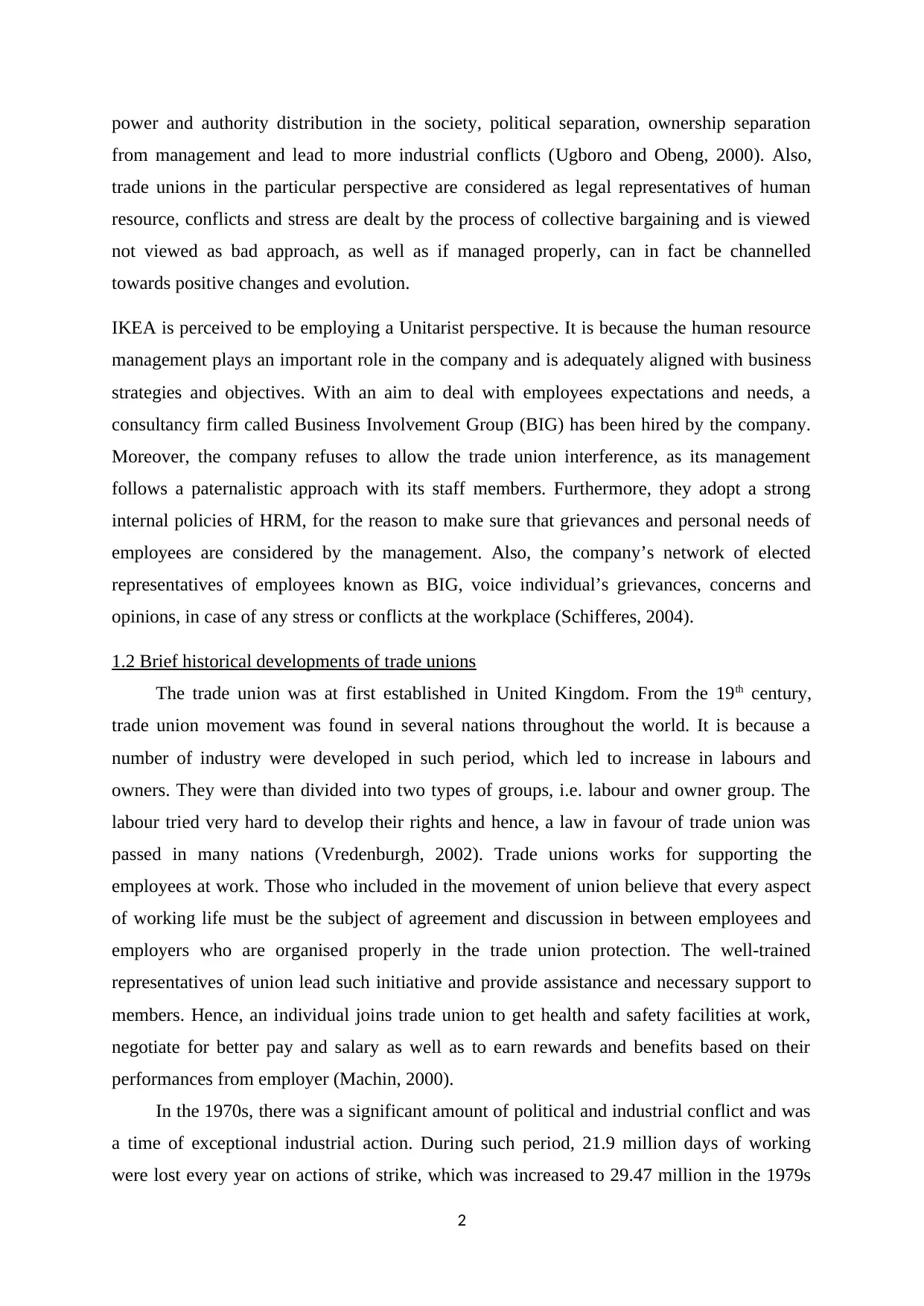
power and authority distribution in the society, political separation, ownership separation
from management and lead to more industrial conflicts (Ugboro and Obeng, 2000). Also,
trade unions in the particular perspective are considered as legal representatives of human
resource, conflicts and stress are dealt by the process of collective bargaining and is viewed
not viewed as bad approach, as well as if managed properly, can in fact be channelled
towards positive changes and evolution.
IKEA is perceived to be employing a Unitarist perspective. It is because the human resource
management plays an important role in the company and is adequately aligned with business
strategies and objectives. With an aim to deal with employees expectations and needs, a
consultancy firm called Business Involvement Group (BIG) has been hired by the company.
Moreover, the company refuses to allow the trade union interference, as its management
follows a paternalistic approach with its staff members. Furthermore, they adopt a strong
internal policies of HRM, for the reason to make sure that grievances and personal needs of
employees are considered by the management. Also, the company’s network of elected
representatives of employees known as BIG, voice individual’s grievances, concerns and
opinions, in case of any stress or conflicts at the workplace (Schifferes, 2004).
1.2 Brief historical developments of trade unions
The trade union was at first established in United Kingdom. From the 19th century,
trade union movement was found in several nations throughout the world. It is because a
number of industry were developed in such period, which led to increase in labours and
owners. They were than divided into two types of groups, i.e. labour and owner group. The
labour tried very hard to develop their rights and hence, a law in favour of trade union was
passed in many nations (Vredenburgh, 2002). Trade unions works for supporting the
employees at work. Those who included in the movement of union believe that every aspect
of working life must be the subject of agreement and discussion in between employees and
employers who are organised properly in the trade union protection. The well-trained
representatives of union lead such initiative and provide assistance and necessary support to
members. Hence, an individual joins trade union to get health and safety facilities at work,
negotiate for better pay and salary as well as to earn rewards and benefits based on their
performances from employer (Machin, 2000).
In the 1970s, there was a significant amount of political and industrial conflict and was
a time of exceptional industrial action. During such period, 21.9 million days of working
were lost every year on actions of strike, which was increased to 29.47 million in the 1979s
2
from management and lead to more industrial conflicts (Ugboro and Obeng, 2000). Also,
trade unions in the particular perspective are considered as legal representatives of human
resource, conflicts and stress are dealt by the process of collective bargaining and is viewed
not viewed as bad approach, as well as if managed properly, can in fact be channelled
towards positive changes and evolution.
IKEA is perceived to be employing a Unitarist perspective. It is because the human resource
management plays an important role in the company and is adequately aligned with business
strategies and objectives. With an aim to deal with employees expectations and needs, a
consultancy firm called Business Involvement Group (BIG) has been hired by the company.
Moreover, the company refuses to allow the trade union interference, as its management
follows a paternalistic approach with its staff members. Furthermore, they adopt a strong
internal policies of HRM, for the reason to make sure that grievances and personal needs of
employees are considered by the management. Also, the company’s network of elected
representatives of employees known as BIG, voice individual’s grievances, concerns and
opinions, in case of any stress or conflicts at the workplace (Schifferes, 2004).
1.2 Brief historical developments of trade unions
The trade union was at first established in United Kingdom. From the 19th century,
trade union movement was found in several nations throughout the world. It is because a
number of industry were developed in such period, which led to increase in labours and
owners. They were than divided into two types of groups, i.e. labour and owner group. The
labour tried very hard to develop their rights and hence, a law in favour of trade union was
passed in many nations (Vredenburgh, 2002). Trade unions works for supporting the
employees at work. Those who included in the movement of union believe that every aspect
of working life must be the subject of agreement and discussion in between employees and
employers who are organised properly in the trade union protection. The well-trained
representatives of union lead such initiative and provide assistance and necessary support to
members. Hence, an individual joins trade union to get health and safety facilities at work,
negotiate for better pay and salary as well as to earn rewards and benefits based on their
performances from employer (Machin, 2000).
In the 1970s, there was a significant amount of political and industrial conflict and was
a time of exceptional industrial action. During such period, 21.9 million days of working
were lost every year on actions of strike, which was increased to 29.47 million in the 1979s
2
Paraphrase This Document
Need a fresh take? Get an instant paraphrase of this document with our AI Paraphraser
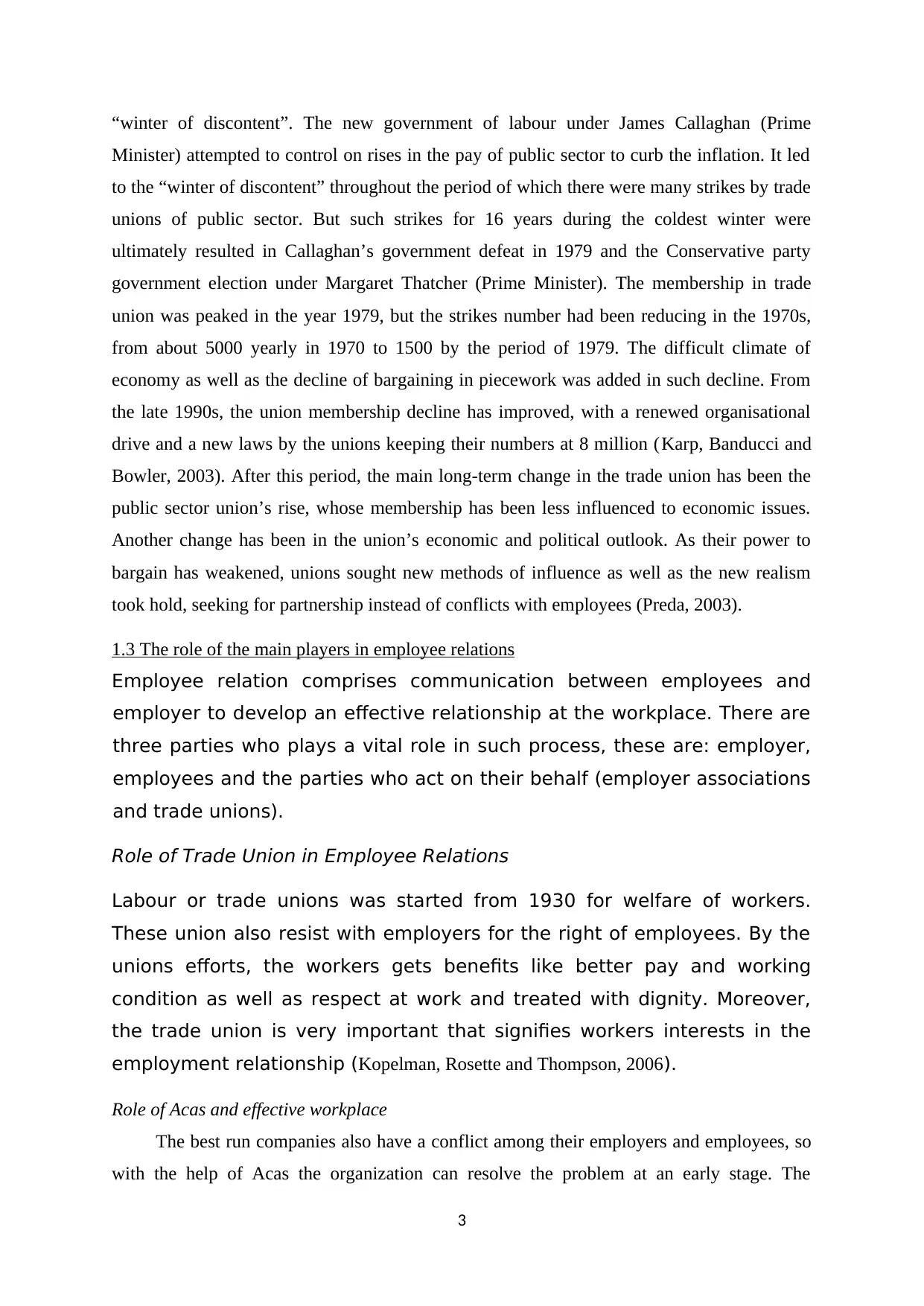
“winter of discontent”. The new government of labour under James Callaghan (Prime
Minister) attempted to control on rises in the pay of public sector to curb the inflation. It led
to the “winter of discontent” throughout the period of which there were many strikes by trade
unions of public sector. But such strikes for 16 years during the coldest winter were
ultimately resulted in Callaghan’s government defeat in 1979 and the Conservative party
government election under Margaret Thatcher (Prime Minister). The membership in trade
union was peaked in the year 1979, but the strikes number had been reducing in the 1970s,
from about 5000 yearly in 1970 to 1500 by the period of 1979. The difficult climate of
economy as well as the decline of bargaining in piecework was added in such decline. From
the late 1990s, the union membership decline has improved, with a renewed organisational
drive and a new laws by the unions keeping their numbers at 8 million (Karp, Banducci and
Bowler, 2003). After this period, the main long-term change in the trade union has been the
public sector union’s rise, whose membership has been less influenced to economic issues.
Another change has been in the union’s economic and political outlook. As their power to
bargain has weakened, unions sought new methods of influence as well as the new realism
took hold, seeking for partnership instead of conflicts with employees (Preda, 2003).
1.3 The role of the main players in employee relations
Employee relation comprises communication between employees and
employer to develop an effective relationship at the workplace. There are
three parties who plays a vital role in such process, these are: employer,
employees and the parties who act on their behalf (employer associations
and trade unions).
Role of Trade Union in Employee Relations
Labour or trade unions was started from 1930 for welfare of workers.
These union also resist with employers for the right of employees. By the
unions efforts, the workers gets benefits like better pay and working
condition as well as respect at work and treated with dignity. Moreover,
the trade union is very important that signifies workers interests in the
employment relationship (Kopelman, Rosette and Thompson, 2006).
Role of Acas and effective workplace
The best run companies also have a conflict among their employers and employees, so
with the help of Acas the organization can resolve the problem at an early stage. The
3
Minister) attempted to control on rises in the pay of public sector to curb the inflation. It led
to the “winter of discontent” throughout the period of which there were many strikes by trade
unions of public sector. But such strikes for 16 years during the coldest winter were
ultimately resulted in Callaghan’s government defeat in 1979 and the Conservative party
government election under Margaret Thatcher (Prime Minister). The membership in trade
union was peaked in the year 1979, but the strikes number had been reducing in the 1970s,
from about 5000 yearly in 1970 to 1500 by the period of 1979. The difficult climate of
economy as well as the decline of bargaining in piecework was added in such decline. From
the late 1990s, the union membership decline has improved, with a renewed organisational
drive and a new laws by the unions keeping their numbers at 8 million (Karp, Banducci and
Bowler, 2003). After this period, the main long-term change in the trade union has been the
public sector union’s rise, whose membership has been less influenced to economic issues.
Another change has been in the union’s economic and political outlook. As their power to
bargain has weakened, unions sought new methods of influence as well as the new realism
took hold, seeking for partnership instead of conflicts with employees (Preda, 2003).
1.3 The role of the main players in employee relations
Employee relation comprises communication between employees and
employer to develop an effective relationship at the workplace. There are
three parties who plays a vital role in such process, these are: employer,
employees and the parties who act on their behalf (employer associations
and trade unions).
Role of Trade Union in Employee Relations
Labour or trade unions was started from 1930 for welfare of workers.
These union also resist with employers for the right of employees. By the
unions efforts, the workers gets benefits like better pay and working
condition as well as respect at work and treated with dignity. Moreover,
the trade union is very important that signifies workers interests in the
employment relationship (Kopelman, Rosette and Thompson, 2006).
Role of Acas and effective workplace
The best run companies also have a conflict among their employers and employees, so
with the help of Acas the organization can resolve the problem at an early stage. The
3
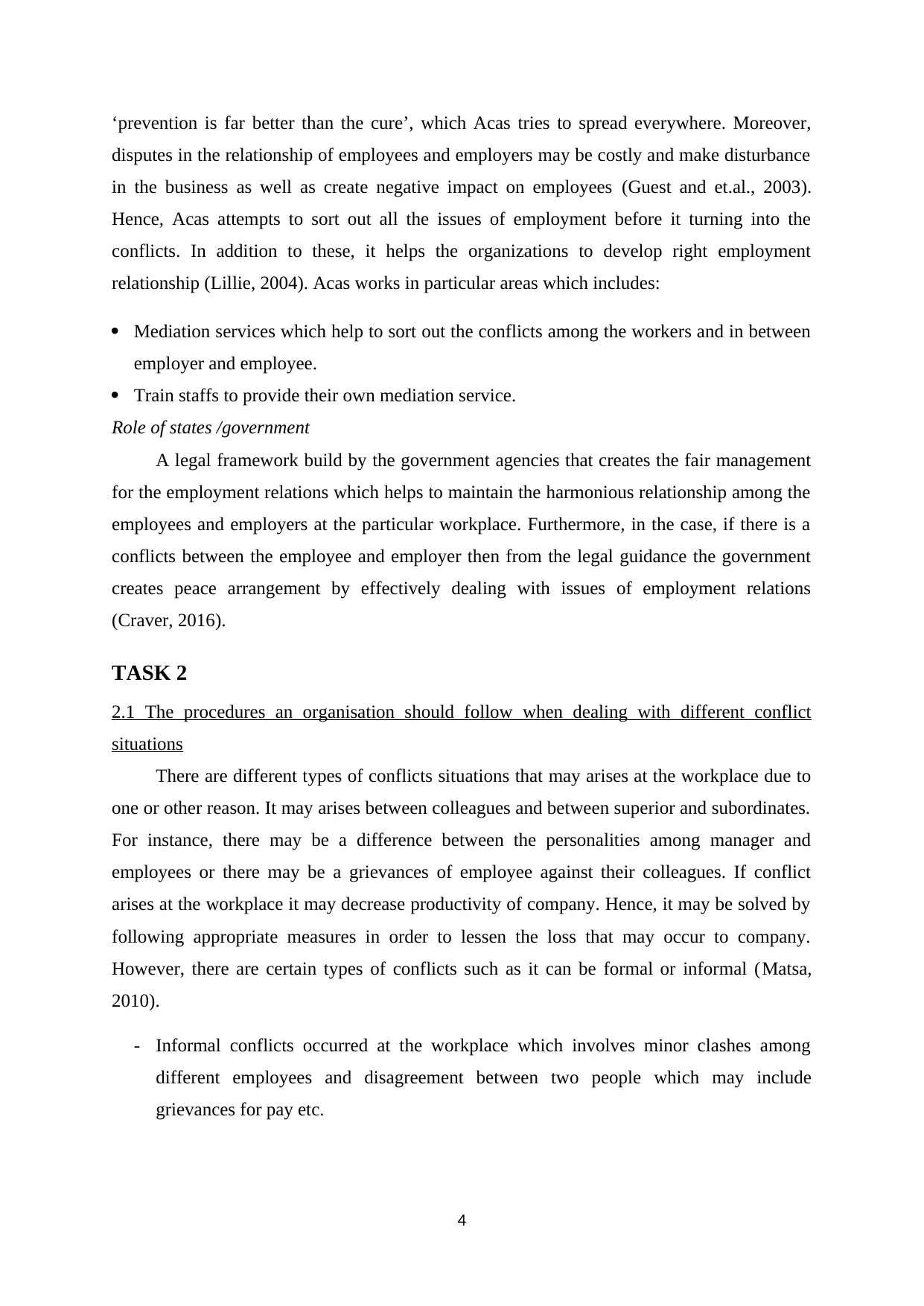
‘prevention is far better than the cure’, which Acas tries to spread everywhere. Moreover,
disputes in the relationship of employees and employers may be costly and make disturbance
in the business as well as create negative impact on employees (Guest and et.al., 2003).
Hence, Acas attempts to sort out all the issues of employment before it turning into the
conflicts. In addition to these, it helps the organizations to develop right employment
relationship (Lillie, 2004). Acas works in particular areas which includes:
Mediation services which help to sort out the conflicts among the workers and in between
employer and employee.
Train staffs to provide their own mediation service.
Role of states /government
A legal framework build by the government agencies that creates the fair management
for the employment relations which helps to maintain the harmonious relationship among the
employees and employers at the particular workplace. Furthermore, in the case, if there is a
conflicts between the employee and employer then from the legal guidance the government
creates peace arrangement by effectively dealing with issues of employment relations
(Craver, 2016).
TASK 2
2.1 The procedures an organisation should follow when dealing with different conflict
situations
There are different types of conflicts situations that may arises at the workplace due to
one or other reason. It may arises between colleagues and between superior and subordinates.
For instance, there may be a difference between the personalities among manager and
employees or there may be a grievances of employee against their colleagues. If conflict
arises at the workplace it may decrease productivity of company. Hence, it may be solved by
following appropriate measures in order to lessen the loss that may occur to company.
However, there are certain types of conflicts such as it can be formal or informal (Matsa,
2010).
- Informal conflicts occurred at the workplace which involves minor clashes among
different employees and disagreement between two people which may include
grievances for pay etc.
4
disputes in the relationship of employees and employers may be costly and make disturbance
in the business as well as create negative impact on employees (Guest and et.al., 2003).
Hence, Acas attempts to sort out all the issues of employment before it turning into the
conflicts. In addition to these, it helps the organizations to develop right employment
relationship (Lillie, 2004). Acas works in particular areas which includes:
Mediation services which help to sort out the conflicts among the workers and in between
employer and employee.
Train staffs to provide their own mediation service.
Role of states /government
A legal framework build by the government agencies that creates the fair management
for the employment relations which helps to maintain the harmonious relationship among the
employees and employers at the particular workplace. Furthermore, in the case, if there is a
conflicts between the employee and employer then from the legal guidance the government
creates peace arrangement by effectively dealing with issues of employment relations
(Craver, 2016).
TASK 2
2.1 The procedures an organisation should follow when dealing with different conflict
situations
There are different types of conflicts situations that may arises at the workplace due to
one or other reason. It may arises between colleagues and between superior and subordinates.
For instance, there may be a difference between the personalities among manager and
employees or there may be a grievances of employee against their colleagues. If conflict
arises at the workplace it may decrease productivity of company. Hence, it may be solved by
following appropriate measures in order to lessen the loss that may occur to company.
However, there are certain types of conflicts such as it can be formal or informal (Matsa,
2010).
- Informal conflicts occurred at the workplace which involves minor clashes among
different employees and disagreement between two people which may include
grievances for pay etc.
4
⊘ This is a preview!⊘
Do you want full access?
Subscribe today to unlock all pages.

Trusted by 1+ million students worldwide
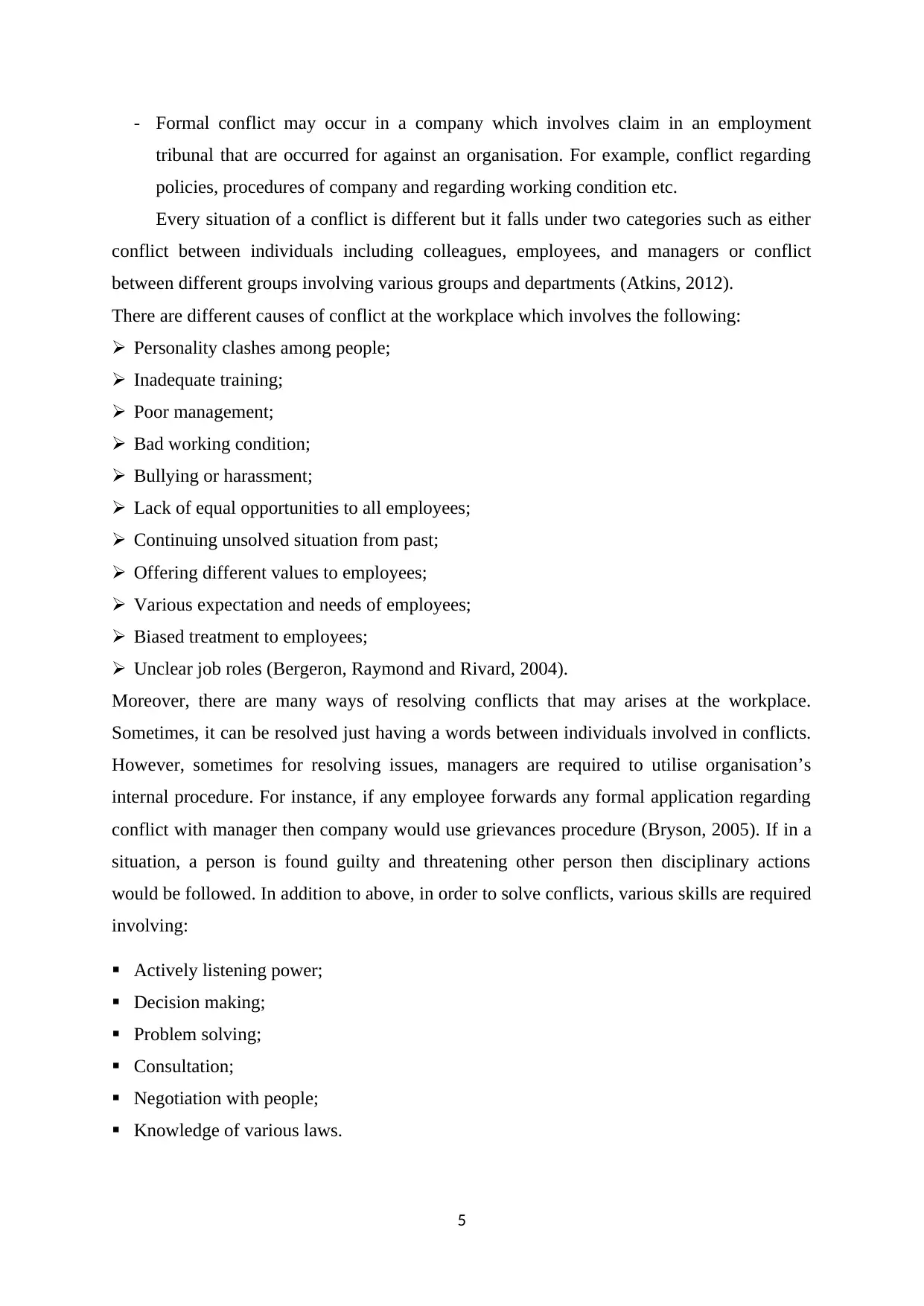
- Formal conflict may occur in a company which involves claim in an employment
tribunal that are occurred for against an organisation. For example, conflict regarding
policies, procedures of company and regarding working condition etc.
Every situation of a conflict is different but it falls under two categories such as either
conflict between individuals including colleagues, employees, and managers or conflict
between different groups involving various groups and departments (Atkins, 2012).
There are different causes of conflict at the workplace which involves the following:
Personality clashes among people;
Inadequate training;
Poor management;
Bad working condition;
Bullying or harassment;
Lack of equal opportunities to all employees;
Continuing unsolved situation from past;
Offering different values to employees;
Various expectation and needs of employees;
Biased treatment to employees;
Unclear job roles (Bergeron, Raymond and Rivard, 2004).
Moreover, there are many ways of resolving conflicts that may arises at the workplace.
Sometimes, it can be resolved just having a words between individuals involved in conflicts.
However, sometimes for resolving issues, managers are required to utilise organisation’s
internal procedure. For instance, if any employee forwards any formal application regarding
conflict with manager then company would use grievances procedure (Bryson, 2005). If in a
situation, a person is found guilty and threatening other person then disciplinary actions
would be followed. In addition to above, in order to solve conflicts, various skills are required
involving:
Actively listening power;
Decision making;
Problem solving;
Consultation;
Negotiation with people;
Knowledge of various laws.
5
tribunal that are occurred for against an organisation. For example, conflict regarding
policies, procedures of company and regarding working condition etc.
Every situation of a conflict is different but it falls under two categories such as either
conflict between individuals including colleagues, employees, and managers or conflict
between different groups involving various groups and departments (Atkins, 2012).
There are different causes of conflict at the workplace which involves the following:
Personality clashes among people;
Inadequate training;
Poor management;
Bad working condition;
Bullying or harassment;
Lack of equal opportunities to all employees;
Continuing unsolved situation from past;
Offering different values to employees;
Various expectation and needs of employees;
Biased treatment to employees;
Unclear job roles (Bergeron, Raymond and Rivard, 2004).
Moreover, there are many ways of resolving conflicts that may arises at the workplace.
Sometimes, it can be resolved just having a words between individuals involved in conflicts.
However, sometimes for resolving issues, managers are required to utilise organisation’s
internal procedure. For instance, if any employee forwards any formal application regarding
conflict with manager then company would use grievances procedure (Bryson, 2005). If in a
situation, a person is found guilty and threatening other person then disciplinary actions
would be followed. In addition to above, in order to solve conflicts, various skills are required
involving:
Actively listening power;
Decision making;
Problem solving;
Consultation;
Negotiation with people;
Knowledge of various laws.
5
Paraphrase This Document
Need a fresh take? Get an instant paraphrase of this document with our AI Paraphraser
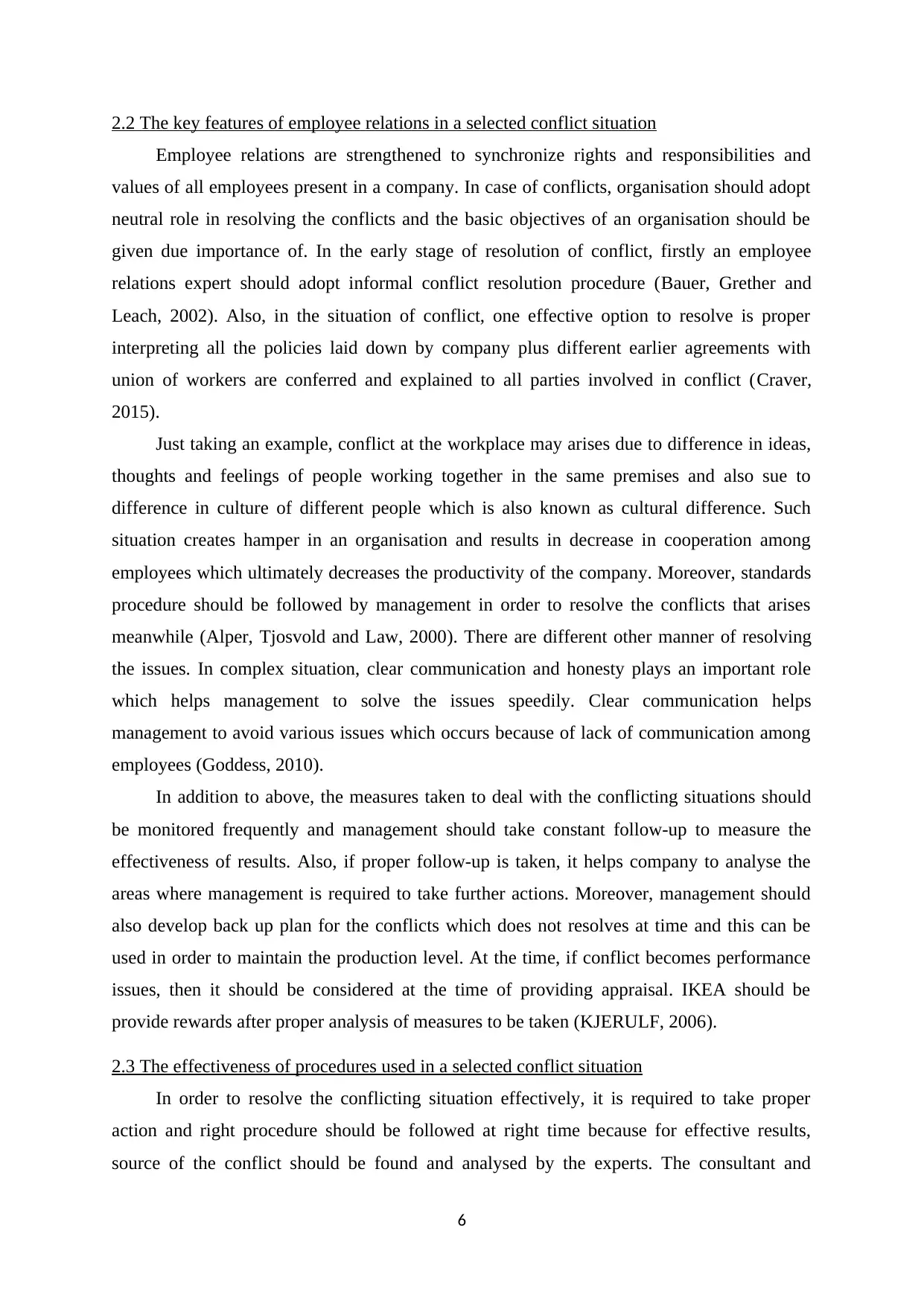
2.2 The key features of employee relations in a selected conflict situation
Employee relations are strengthened to synchronize rights and responsibilities and
values of all employees present in a company. In case of conflicts, organisation should adopt
neutral role in resolving the conflicts and the basic objectives of an organisation should be
given due importance of. In the early stage of resolution of conflict, firstly an employee
relations expert should adopt informal conflict resolution procedure (Bauer, Grether and
Leach, 2002). Also, in the situation of conflict, one effective option to resolve is proper
interpreting all the policies laid down by company plus different earlier agreements with
union of workers are conferred and explained to all parties involved in conflict (Craver,
2015).
Just taking an example, conflict at the workplace may arises due to difference in ideas,
thoughts and feelings of people working together in the same premises and also sue to
difference in culture of different people which is also known as cultural difference. Such
situation creates hamper in an organisation and results in decrease in cooperation among
employees which ultimately decreases the productivity of the company. Moreover, standards
procedure should be followed by management in order to resolve the conflicts that arises
meanwhile (Alper, Tjosvold and Law, 2000). There are different other manner of resolving
the issues. In complex situation, clear communication and honesty plays an important role
which helps management to solve the issues speedily. Clear communication helps
management to avoid various issues which occurs because of lack of communication among
employees (Goddess, 2010).
In addition to above, the measures taken to deal with the conflicting situations should
be monitored frequently and management should take constant follow-up to measure the
effectiveness of results. Also, if proper follow-up is taken, it helps company to analyse the
areas where management is required to take further actions. Moreover, management should
also develop back up plan for the conflicts which does not resolves at time and this can be
used in order to maintain the production level. At the time, if conflict becomes performance
issues, then it should be considered at the time of providing appraisal. IKEA should be
provide rewards after proper analysis of measures to be taken (KJERULF, 2006).
2.3 The effectiveness of procedures used in a selected conflict situation
In order to resolve the conflicting situation effectively, it is required to take proper
action and right procedure should be followed at right time because for effective results,
source of the conflict should be found and analysed by the experts. The consultant and
6
Employee relations are strengthened to synchronize rights and responsibilities and
values of all employees present in a company. In case of conflicts, organisation should adopt
neutral role in resolving the conflicts and the basic objectives of an organisation should be
given due importance of. In the early stage of resolution of conflict, firstly an employee
relations expert should adopt informal conflict resolution procedure (Bauer, Grether and
Leach, 2002). Also, in the situation of conflict, one effective option to resolve is proper
interpreting all the policies laid down by company plus different earlier agreements with
union of workers are conferred and explained to all parties involved in conflict (Craver,
2015).
Just taking an example, conflict at the workplace may arises due to difference in ideas,
thoughts and feelings of people working together in the same premises and also sue to
difference in culture of different people which is also known as cultural difference. Such
situation creates hamper in an organisation and results in decrease in cooperation among
employees which ultimately decreases the productivity of the company. Moreover, standards
procedure should be followed by management in order to resolve the conflicts that arises
meanwhile (Alper, Tjosvold and Law, 2000). There are different other manner of resolving
the issues. In complex situation, clear communication and honesty plays an important role
which helps management to solve the issues speedily. Clear communication helps
management to avoid various issues which occurs because of lack of communication among
employees (Goddess, 2010).
In addition to above, the measures taken to deal with the conflicting situations should
be monitored frequently and management should take constant follow-up to measure the
effectiveness of results. Also, if proper follow-up is taken, it helps company to analyse the
areas where management is required to take further actions. Moreover, management should
also develop back up plan for the conflicts which does not resolves at time and this can be
used in order to maintain the production level. At the time, if conflict becomes performance
issues, then it should be considered at the time of providing appraisal. IKEA should be
provide rewards after proper analysis of measures to be taken (KJERULF, 2006).
2.3 The effectiveness of procedures used in a selected conflict situation
In order to resolve the conflicting situation effectively, it is required to take proper
action and right procedure should be followed at right time because for effective results,
source of the conflict should be found and analysed by the experts. The consultant and
6
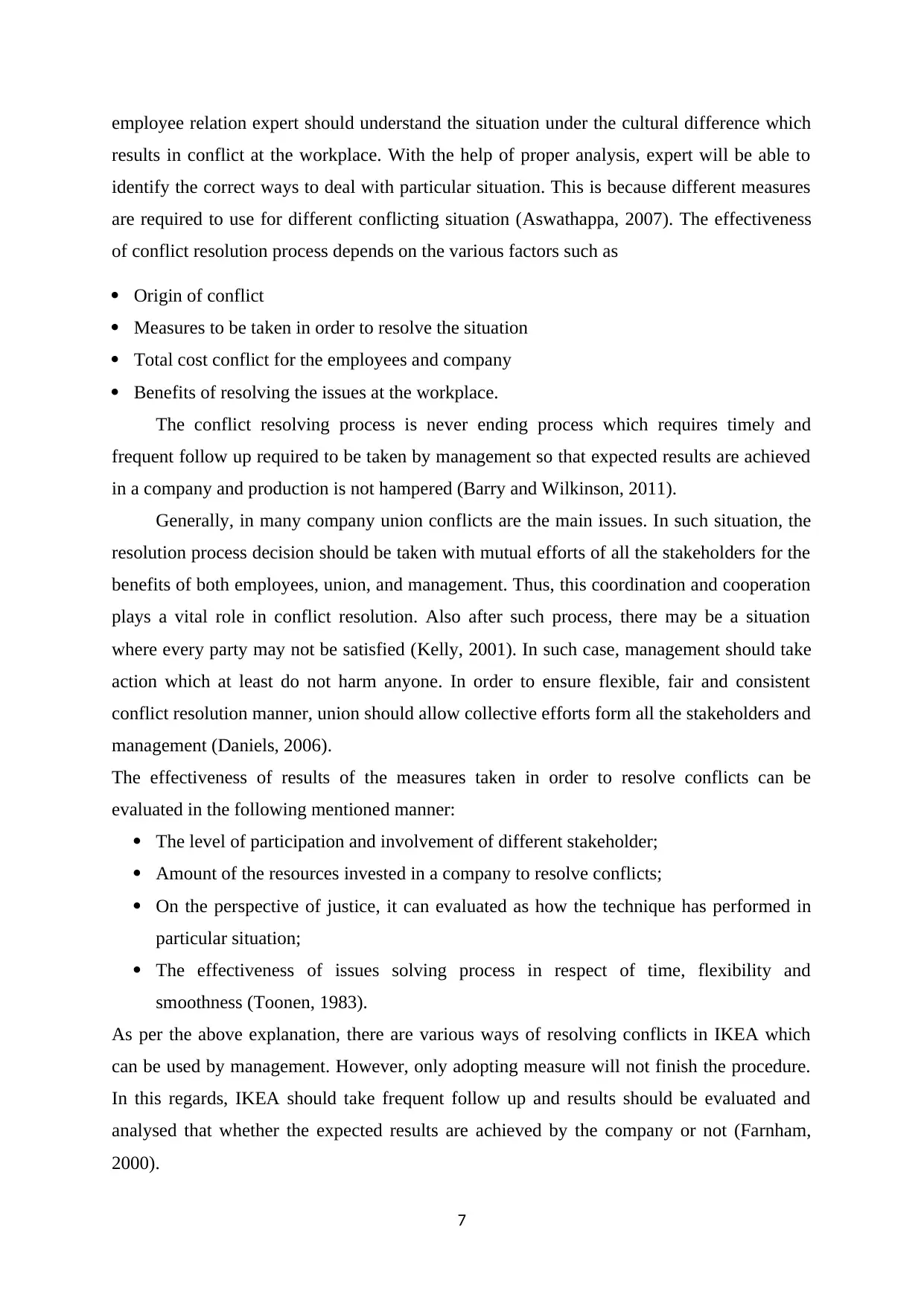
employee relation expert should understand the situation under the cultural difference which
results in conflict at the workplace. With the help of proper analysis, expert will be able to
identify the correct ways to deal with particular situation. This is because different measures
are required to use for different conflicting situation (Aswathappa, 2007). The effectiveness
of conflict resolution process depends on the various factors such as
Origin of conflict
Measures to be taken in order to resolve the situation
Total cost conflict for the employees and company
Benefits of resolving the issues at the workplace.
The conflict resolving process is never ending process which requires timely and
frequent follow up required to be taken by management so that expected results are achieved
in a company and production is not hampered (Barry and Wilkinson, 2011).
Generally, in many company union conflicts are the main issues. In such situation, the
resolution process decision should be taken with mutual efforts of all the stakeholders for the
benefits of both employees, union, and management. Thus, this coordination and cooperation
plays a vital role in conflict resolution. Also after such process, there may be a situation
where every party may not be satisfied (Kelly, 2001). In such case, management should take
action which at least do not harm anyone. In order to ensure flexible, fair and consistent
conflict resolution manner, union should allow collective efforts form all the stakeholders and
management (Daniels, 2006).
The effectiveness of results of the measures taken in order to resolve conflicts can be
evaluated in the following mentioned manner:
The level of participation and involvement of different stakeholder;
Amount of the resources invested in a company to resolve conflicts;
On the perspective of justice, it can evaluated as how the technique has performed in
particular situation;
The effectiveness of issues solving process in respect of time, flexibility and
smoothness (Toonen, 1983).
As per the above explanation, there are various ways of resolving conflicts in IKEA which
can be used by management. However, only adopting measure will not finish the procedure.
In this regards, IKEA should take frequent follow up and results should be evaluated and
analysed that whether the expected results are achieved by the company or not (Farnham,
2000).
7
results in conflict at the workplace. With the help of proper analysis, expert will be able to
identify the correct ways to deal with particular situation. This is because different measures
are required to use for different conflicting situation (Aswathappa, 2007). The effectiveness
of conflict resolution process depends on the various factors such as
Origin of conflict
Measures to be taken in order to resolve the situation
Total cost conflict for the employees and company
Benefits of resolving the issues at the workplace.
The conflict resolving process is never ending process which requires timely and
frequent follow up required to be taken by management so that expected results are achieved
in a company and production is not hampered (Barry and Wilkinson, 2011).
Generally, in many company union conflicts are the main issues. In such situation, the
resolution process decision should be taken with mutual efforts of all the stakeholders for the
benefits of both employees, union, and management. Thus, this coordination and cooperation
plays a vital role in conflict resolution. Also after such process, there may be a situation
where every party may not be satisfied (Kelly, 2001). In such case, management should take
action which at least do not harm anyone. In order to ensure flexible, fair and consistent
conflict resolution manner, union should allow collective efforts form all the stakeholders and
management (Daniels, 2006).
The effectiveness of results of the measures taken in order to resolve conflicts can be
evaluated in the following mentioned manner:
The level of participation and involvement of different stakeholder;
Amount of the resources invested in a company to resolve conflicts;
On the perspective of justice, it can evaluated as how the technique has performed in
particular situation;
The effectiveness of issues solving process in respect of time, flexibility and
smoothness (Toonen, 1983).
As per the above explanation, there are various ways of resolving conflicts in IKEA which
can be used by management. However, only adopting measure will not finish the procedure.
In this regards, IKEA should take frequent follow up and results should be evaluated and
analysed that whether the expected results are achieved by the company or not (Farnham,
2000).
7
⊘ This is a preview!⊘
Do you want full access?
Subscribe today to unlock all pages.

Trusted by 1+ million students worldwide
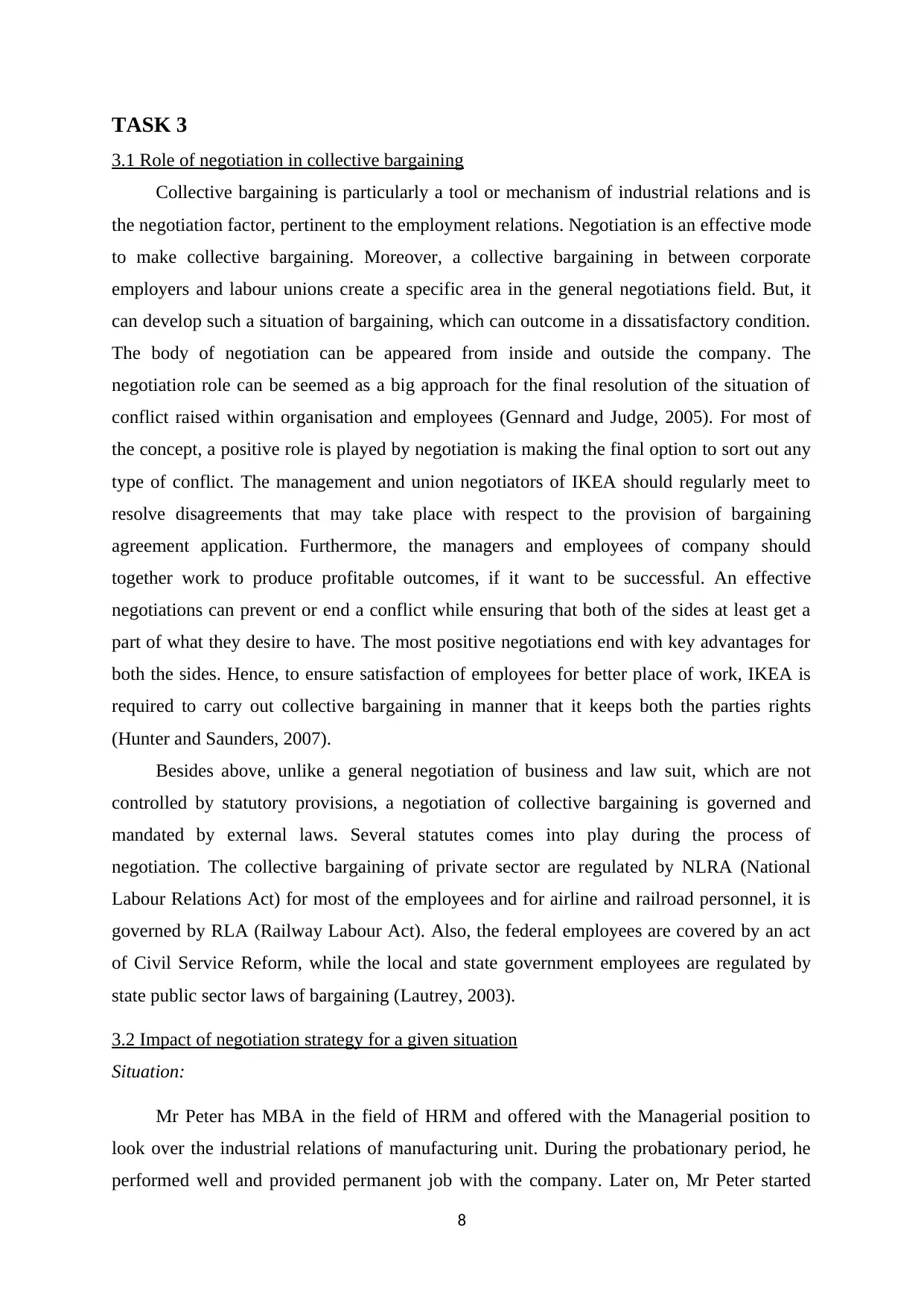
TASK 3
3.1 Role of negotiation in collective bargaining
Collective bargaining is particularly a tool or mechanism of industrial relations and is
the negotiation factor, pertinent to the employment relations. Negotiation is an effective mode
to make collective bargaining. Moreover, a collective bargaining in between corporate
employers and labour unions create a specific area in the general negotiations field. But, it
can develop such a situation of bargaining, which can outcome in a dissatisfactory condition.
The body of negotiation can be appeared from inside and outside the company. The
negotiation role can be seemed as a big approach for the final resolution of the situation of
conflict raised within organisation and employees (Gennard and Judge, 2005). For most of
the concept, a positive role is played by negotiation is making the final option to sort out any
type of conflict. The management and union negotiators of IKEA should regularly meet to
resolve disagreements that may take place with respect to the provision of bargaining
agreement application. Furthermore, the managers and employees of company should
together work to produce profitable outcomes, if it want to be successful. An effective
negotiations can prevent or end a conflict while ensuring that both of the sides at least get a
part of what they desire to have. The most positive negotiations end with key advantages for
both the sides. Hence, to ensure satisfaction of employees for better place of work, IKEA is
required to carry out collective bargaining in manner that it keeps both the parties rights
(Hunter and Saunders, 2007).
Besides above, unlike a general negotiation of business and law suit, which are not
controlled by statutory provisions, a negotiation of collective bargaining is governed and
mandated by external laws. Several statutes comes into play during the process of
negotiation. The collective bargaining of private sector are regulated by NLRA (National
Labour Relations Act) for most of the employees and for airline and railroad personnel, it is
governed by RLA (Railway Labour Act). Also, the federal employees are covered by an act
of Civil Service Reform, while the local and state government employees are regulated by
state public sector laws of bargaining (Lautrey, 2003).
3.2 Impact of negotiation strategy for a given situation
Situation:
Mr Peter has MBA in the field of HRM and offered with the Managerial position to
look over the industrial relations of manufacturing unit. During the probationary period, he
performed well and provided permanent job with the company. Later on, Mr Peter started
8
3.1 Role of negotiation in collective bargaining
Collective bargaining is particularly a tool or mechanism of industrial relations and is
the negotiation factor, pertinent to the employment relations. Negotiation is an effective mode
to make collective bargaining. Moreover, a collective bargaining in between corporate
employers and labour unions create a specific area in the general negotiations field. But, it
can develop such a situation of bargaining, which can outcome in a dissatisfactory condition.
The body of negotiation can be appeared from inside and outside the company. The
negotiation role can be seemed as a big approach for the final resolution of the situation of
conflict raised within organisation and employees (Gennard and Judge, 2005). For most of
the concept, a positive role is played by negotiation is making the final option to sort out any
type of conflict. The management and union negotiators of IKEA should regularly meet to
resolve disagreements that may take place with respect to the provision of bargaining
agreement application. Furthermore, the managers and employees of company should
together work to produce profitable outcomes, if it want to be successful. An effective
negotiations can prevent or end a conflict while ensuring that both of the sides at least get a
part of what they desire to have. The most positive negotiations end with key advantages for
both the sides. Hence, to ensure satisfaction of employees for better place of work, IKEA is
required to carry out collective bargaining in manner that it keeps both the parties rights
(Hunter and Saunders, 2007).
Besides above, unlike a general negotiation of business and law suit, which are not
controlled by statutory provisions, a negotiation of collective bargaining is governed and
mandated by external laws. Several statutes comes into play during the process of
negotiation. The collective bargaining of private sector are regulated by NLRA (National
Labour Relations Act) for most of the employees and for airline and railroad personnel, it is
governed by RLA (Railway Labour Act). Also, the federal employees are covered by an act
of Civil Service Reform, while the local and state government employees are regulated by
state public sector laws of bargaining (Lautrey, 2003).
3.2 Impact of negotiation strategy for a given situation
Situation:
Mr Peter has MBA in the field of HRM and offered with the Managerial position to
look over the industrial relations of manufacturing unit. During the probationary period, he
performed well and provided permanent job with the company. Later on, Mr Peter started
8
Paraphrase This Document
Need a fresh take? Get an instant paraphrase of this document with our AI Paraphraser
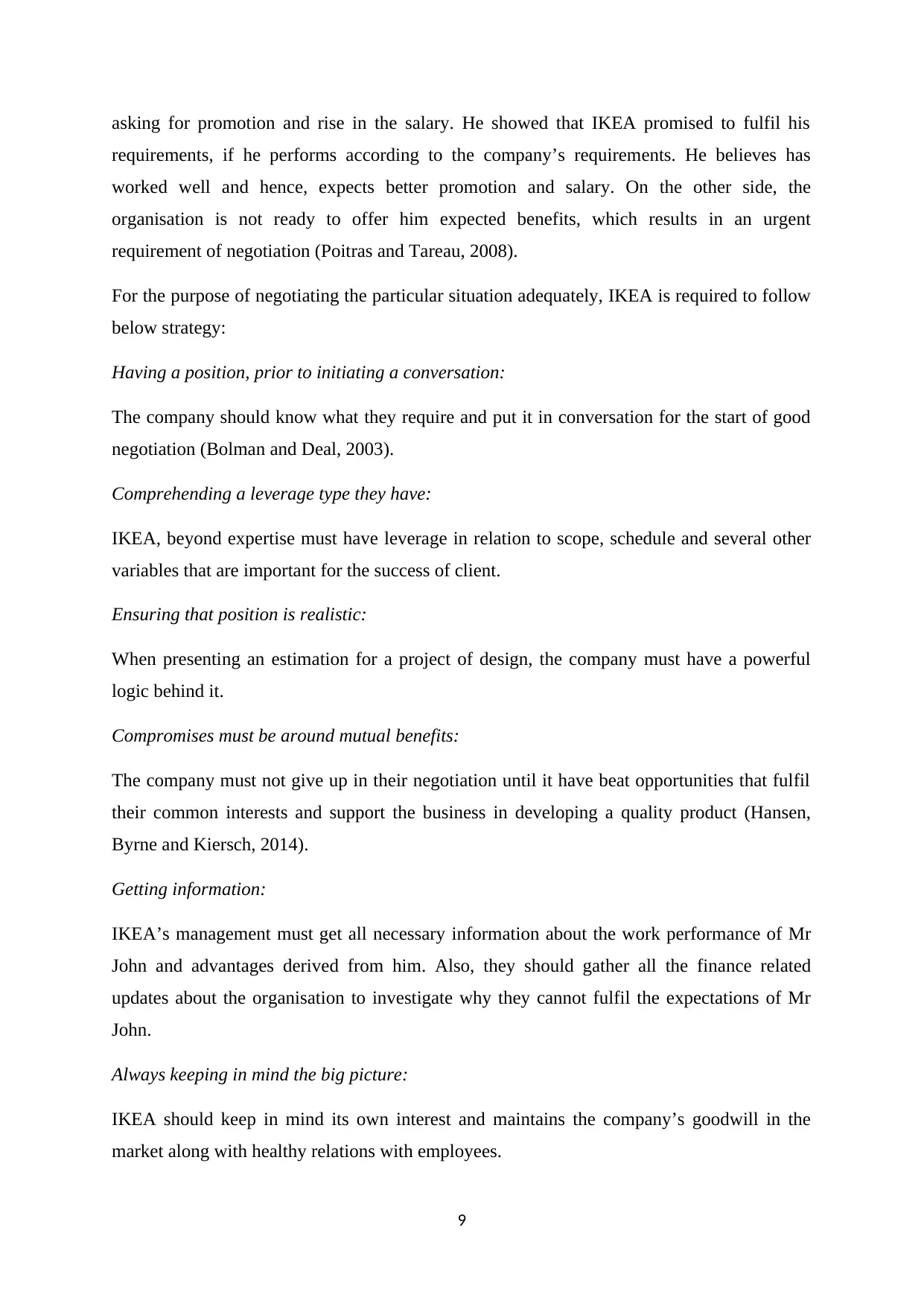
asking for promotion and rise in the salary. He showed that IKEA promised to fulfil his
requirements, if he performs according to the company’s requirements. He believes has
worked well and hence, expects better promotion and salary. On the other side, the
organisation is not ready to offer him expected benefits, which results in an urgent
requirement of negotiation (Poitras and Tareau, 2008).
For the purpose of negotiating the particular situation adequately, IKEA is required to follow
below strategy:
Having a position, prior to initiating a conversation:
The company should know what they require and put it in conversation for the start of good
negotiation (Bolman and Deal, 2003).
Comprehending a leverage type they have:
IKEA, beyond expertise must have leverage in relation to scope, schedule and several other
variables that are important for the success of client.
Ensuring that position is realistic:
When presenting an estimation for a project of design, the company must have a powerful
logic behind it.
Compromises must be around mutual benefits:
The company must not give up in their negotiation until it have beat opportunities that fulfil
their common interests and support the business in developing a quality product (Hansen,
Byrne and Kiersch, 2014).
Getting information:
IKEA’s management must get all necessary information about the work performance of Mr
John and advantages derived from him. Also, they should gather all the finance related
updates about the organisation to investigate why they cannot fulfil the expectations of Mr
John.
Always keeping in mind the big picture:
IKEA should keep in mind its own interest and maintains the company’s goodwill in the
market along with healthy relations with employees.
9
requirements, if he performs according to the company’s requirements. He believes has
worked well and hence, expects better promotion and salary. On the other side, the
organisation is not ready to offer him expected benefits, which results in an urgent
requirement of negotiation (Poitras and Tareau, 2008).
For the purpose of negotiating the particular situation adequately, IKEA is required to follow
below strategy:
Having a position, prior to initiating a conversation:
The company should know what they require and put it in conversation for the start of good
negotiation (Bolman and Deal, 2003).
Comprehending a leverage type they have:
IKEA, beyond expertise must have leverage in relation to scope, schedule and several other
variables that are important for the success of client.
Ensuring that position is realistic:
When presenting an estimation for a project of design, the company must have a powerful
logic behind it.
Compromises must be around mutual benefits:
The company must not give up in their negotiation until it have beat opportunities that fulfil
their common interests and support the business in developing a quality product (Hansen,
Byrne and Kiersch, 2014).
Getting information:
IKEA’s management must get all necessary information about the work performance of Mr
John and advantages derived from him. Also, they should gather all the finance related
updates about the organisation to investigate why they cannot fulfil the expectations of Mr
John.
Always keeping in mind the big picture:
IKEA should keep in mind its own interest and maintains the company’s goodwill in the
market along with healthy relations with employees.
9
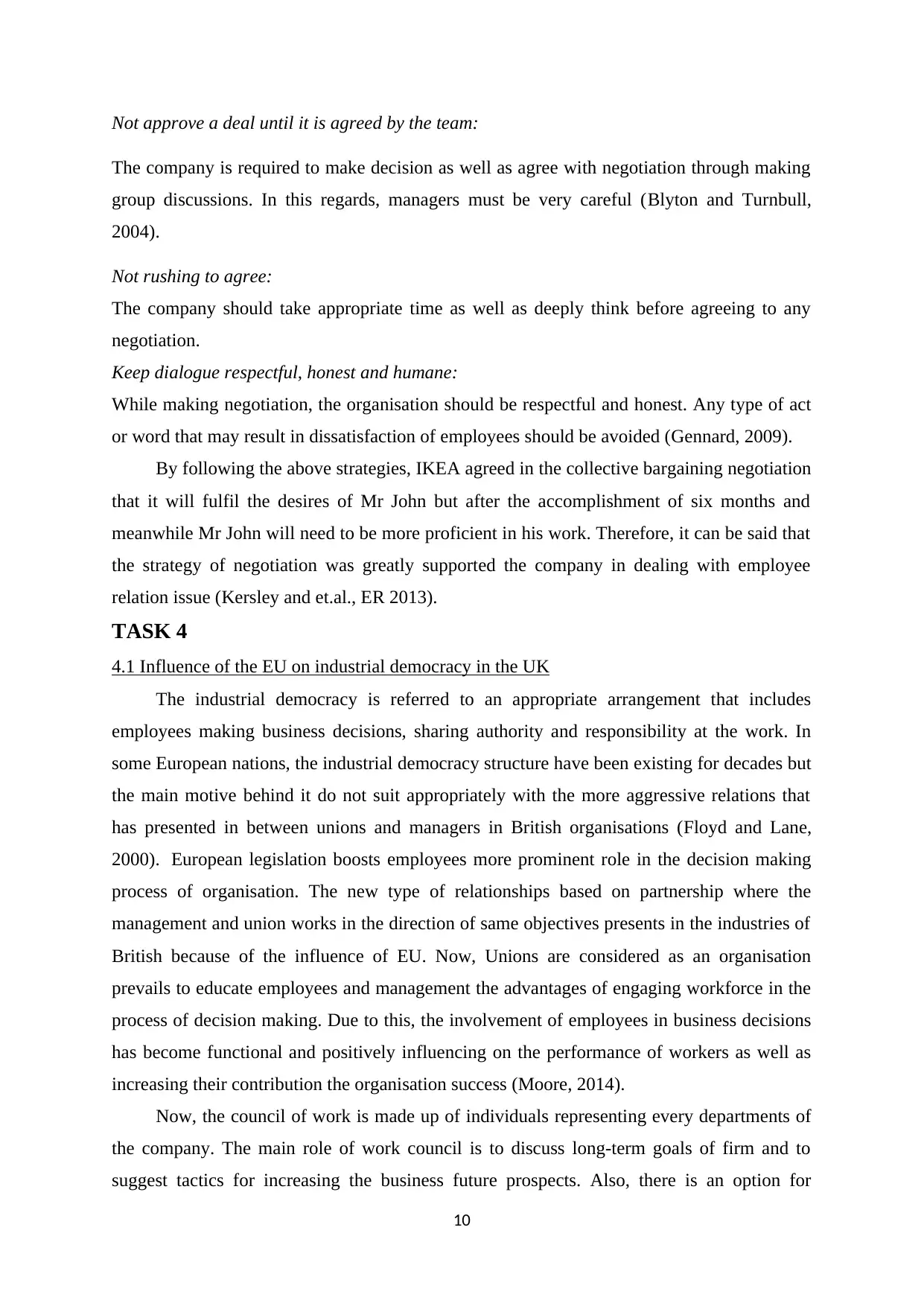
Not approve a deal until it is agreed by the team:
The company is required to make decision as well as agree with negotiation through making
group discussions. In this regards, managers must be very careful (Blyton and Turnbull,
2004).
Not rushing to agree:
The company should take appropriate time as well as deeply think before agreeing to any
negotiation.
Keep dialogue respectful, honest and humane:
While making negotiation, the organisation should be respectful and honest. Any type of act
or word that may result in dissatisfaction of employees should be avoided (Gennard, 2009).
By following the above strategies, IKEA agreed in the collective bargaining negotiation
that it will fulfil the desires of Mr John but after the accomplishment of six months and
meanwhile Mr John will need to be more proficient in his work. Therefore, it can be said that
the strategy of negotiation was greatly supported the company in dealing with employee
relation issue (Kersley and et.al., ER 2013).
TASK 4
4.1 Influence of the EU on industrial democracy in the UK
The industrial democracy is referred to an appropriate arrangement that includes
employees making business decisions, sharing authority and responsibility at the work. In
some European nations, the industrial democracy structure have been existing for decades but
the main motive behind it do not suit appropriately with the more aggressive relations that
has presented in between unions and managers in British organisations (Floyd and Lane,
2000). European legislation boosts employees more prominent role in the decision making
process of organisation. The new type of relationships based on partnership where the
management and union works in the direction of same objectives presents in the industries of
British because of the influence of EU. Now, Unions are considered as an organisation
prevails to educate employees and management the advantages of engaging workforce in the
process of decision making. Due to this, the involvement of employees in business decisions
has become functional and positively influencing on the performance of workers as well as
increasing their contribution the organisation success (Moore, 2014).
Now, the council of work is made up of individuals representing every departments of
the company. The main role of work council is to discuss long-term goals of firm and to
suggest tactics for increasing the business future prospects. Also, there is an option for
10
The company is required to make decision as well as agree with negotiation through making
group discussions. In this regards, managers must be very careful (Blyton and Turnbull,
2004).
Not rushing to agree:
The company should take appropriate time as well as deeply think before agreeing to any
negotiation.
Keep dialogue respectful, honest and humane:
While making negotiation, the organisation should be respectful and honest. Any type of act
or word that may result in dissatisfaction of employees should be avoided (Gennard, 2009).
By following the above strategies, IKEA agreed in the collective bargaining negotiation
that it will fulfil the desires of Mr John but after the accomplishment of six months and
meanwhile Mr John will need to be more proficient in his work. Therefore, it can be said that
the strategy of negotiation was greatly supported the company in dealing with employee
relation issue (Kersley and et.al., ER 2013).
TASK 4
4.1 Influence of the EU on industrial democracy in the UK
The industrial democracy is referred to an appropriate arrangement that includes
employees making business decisions, sharing authority and responsibility at the work. In
some European nations, the industrial democracy structure have been existing for decades but
the main motive behind it do not suit appropriately with the more aggressive relations that
has presented in between unions and managers in British organisations (Floyd and Lane,
2000). European legislation boosts employees more prominent role in the decision making
process of organisation. The new type of relationships based on partnership where the
management and union works in the direction of same objectives presents in the industries of
British because of the influence of EU. Now, Unions are considered as an organisation
prevails to educate employees and management the advantages of engaging workforce in the
process of decision making. Due to this, the involvement of employees in business decisions
has become functional and positively influencing on the performance of workers as well as
increasing their contribution the organisation success (Moore, 2014).
Now, the council of work is made up of individuals representing every departments of
the company. The main role of work council is to discuss long-term goals of firm and to
suggest tactics for increasing the business future prospects. Also, there is an option for
10
⊘ This is a preview!⊘
Do you want full access?
Subscribe today to unlock all pages.

Trusted by 1+ million students worldwide
1 out of 18
Related Documents
Your All-in-One AI-Powered Toolkit for Academic Success.
+13062052269
info@desklib.com
Available 24*7 on WhatsApp / Email
![[object Object]](/_next/static/media/star-bottom.7253800d.svg)
Unlock your academic potential
Copyright © 2020–2025 A2Z Services. All Rights Reserved. Developed and managed by ZUCOL.





